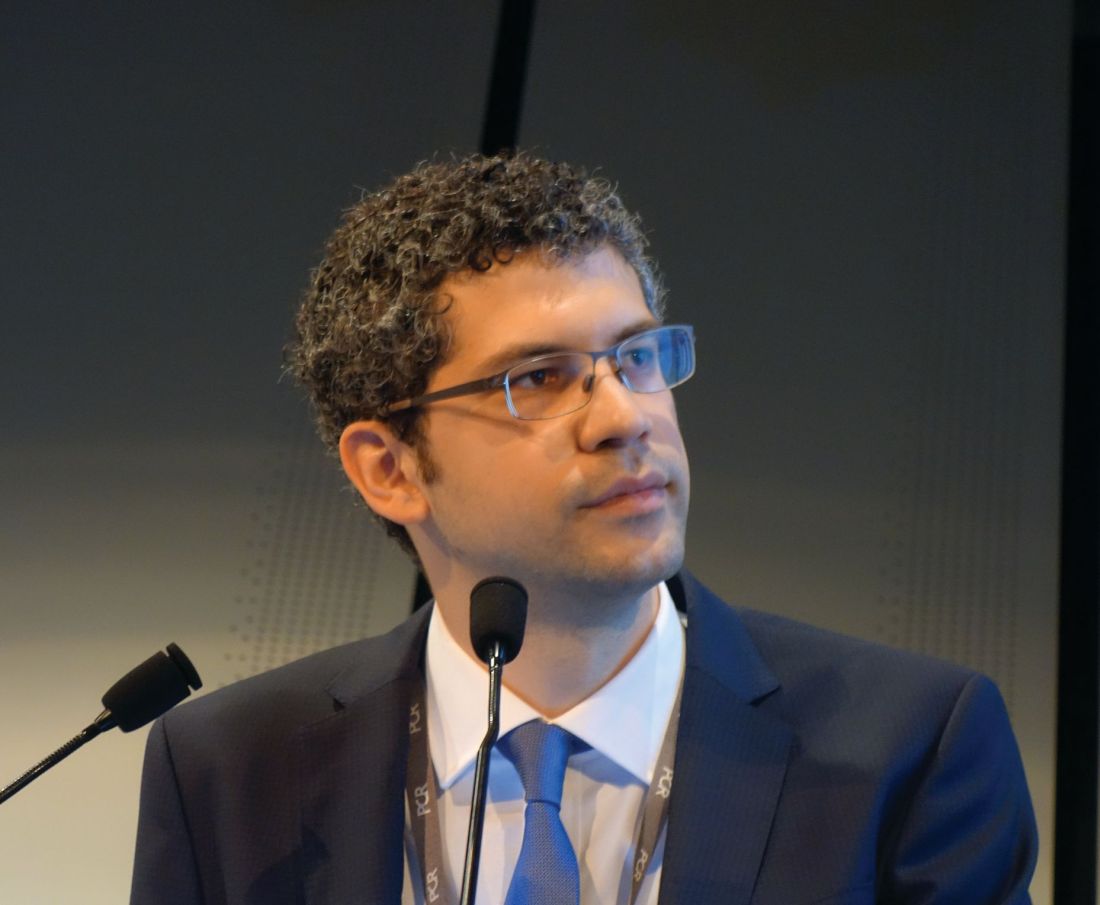User login
PARIS – The Synergy bioabsorbable polymer everolimus-eluting stent performed equally well for treatment of acute MI, compared with other newer-generation drug-eluting stents, through 2 years of follow-up in a massive observational study of all patients undergoing percutaneous coronary intervention in Sweden during a recent multiyear period.
This report from the prospective Swedish Coronary Angiography and Angioplasty Registry (SCAAR) was undertaken because, even though the Synergy stent has demonstrated outstanding clinical results in randomized trials and observational studies, the stent’s performance specifically in the setting of acute MI had not previously been investigated, Sergio Buccheri, MD, noted at the annual meeting of the European Association of Percutaneous Cardiovascular Interventions.
SCAAR, which documents every PCI performed in Sweden, provided the capability to fill that important knowledge gap in an unselected real-world population of acute MI patients. Dr. Buccheri, of Uppsala (Sweden) University, reported on 36,292 consecutive patients who underwent PCI with a newer-generation drug-eluting stent (DES) in Sweden from March 2013 to September 2016. Forty percent of them had ST-elevation MI. The Synergy stent was used in 4,889 patients. Among the most commonly used newer DES in the other 31,000-plus patients were the Xience Xpedition, the Resolute Integrity and Resolute Onyx, the Orsiro, BioMatrix, and Promus Element Plus and Promus Premier.
The coprimary endpoints in this analysis were the rates of definite stent thrombosis and clinically relevant restenosis at 2 years of follow-up. Stent thrombosis occurred in 0.69% of the Synergy patients and 0.81% of those who received other newer-generation DES, a nonsignificant difference. Similarly, no significant difference was found in the rate of clinically relevant restenosis: 1.48% and 1.25%, respectively.
“,” Dr. Buccheri noted. “These findings may be useful to support a more informed and evidence-based stent selection process in daily clinical practice.”
The key secondary outcomes were all-cause mortality and recurrent MI. Again, there were no significant between-group differences. The cumulative all-cause mortality at 2 years was 10.1% in the Synergy group and 9.1% in the others. Recurrent MI occurred in 6.49% of the Synergy group and 6.32% with other DES.
Patients who received the Synergy stent were on average older, had a higher burden of cardiovascular risk factors, and presented more often with left main, triple-vessel disease or vein graft lesions. For that reason, Dr. Buccheri and his coinvestigators developed a propensity score using an array of covariates to adjust for these differences. Plugging those scores into multivariate Cox regression models, there remained no significant differences between the two groups in the adjusted risk of any of the endpoints.
Operators were advised to use dual antiplatelet therapy for 12 months in all patients. However, SCAAR does not include data on adherence to DAPT, which is a study limitation, Dr. Buccheri noted.
The Synergy stent is made up of a thin strut chromium-platinum platform with a bioabsorbable polymer that releases everolimus. The polymer is completely reabsorbed within 4 months, leaving behind a bare metal stent. In animal models, this has been associated with lower levels of inflammation, compared with permanent polymer DES. And inflammation is thought to be one of the main mechanisms underlying stent failure in the late and very late phases after PCI.
The discussion panel was clearly impressed with – and envious of – the sheer size of the SCAAR study population. As one panelist noted, real-life data of this magnitude can really only be obtained in Sweden. Another panelist confessed: “We’re shy of presenting our own studies when we see these numbers.”
Simultaneously with Dr. Buccheri’s presentation, the SCAAR report was published online (EuroIntervention. 2018 May 24. pii: EIJ-D-18-00392. doi: 10.4244/EIJ-D-18-00392).
SCAAR is funded solely by the Swedish government. This study was supported by a grant from Boston Scientific. Dr. Buccheri reported having no financial conflicts of interest.
PARIS – The Synergy bioabsorbable polymer everolimus-eluting stent performed equally well for treatment of acute MI, compared with other newer-generation drug-eluting stents, through 2 years of follow-up in a massive observational study of all patients undergoing percutaneous coronary intervention in Sweden during a recent multiyear period.
This report from the prospective Swedish Coronary Angiography and Angioplasty Registry (SCAAR) was undertaken because, even though the Synergy stent has demonstrated outstanding clinical results in randomized trials and observational studies, the stent’s performance specifically in the setting of acute MI had not previously been investigated, Sergio Buccheri, MD, noted at the annual meeting of the European Association of Percutaneous Cardiovascular Interventions.
SCAAR, which documents every PCI performed in Sweden, provided the capability to fill that important knowledge gap in an unselected real-world population of acute MI patients. Dr. Buccheri, of Uppsala (Sweden) University, reported on 36,292 consecutive patients who underwent PCI with a newer-generation drug-eluting stent (DES) in Sweden from March 2013 to September 2016. Forty percent of them had ST-elevation MI. The Synergy stent was used in 4,889 patients. Among the most commonly used newer DES in the other 31,000-plus patients were the Xience Xpedition, the Resolute Integrity and Resolute Onyx, the Orsiro, BioMatrix, and Promus Element Plus and Promus Premier.
The coprimary endpoints in this analysis were the rates of definite stent thrombosis and clinically relevant restenosis at 2 years of follow-up. Stent thrombosis occurred in 0.69% of the Synergy patients and 0.81% of those who received other newer-generation DES, a nonsignificant difference. Similarly, no significant difference was found in the rate of clinically relevant restenosis: 1.48% and 1.25%, respectively.
“,” Dr. Buccheri noted. “These findings may be useful to support a more informed and evidence-based stent selection process in daily clinical practice.”
The key secondary outcomes were all-cause mortality and recurrent MI. Again, there were no significant between-group differences. The cumulative all-cause mortality at 2 years was 10.1% in the Synergy group and 9.1% in the others. Recurrent MI occurred in 6.49% of the Synergy group and 6.32% with other DES.
Patients who received the Synergy stent were on average older, had a higher burden of cardiovascular risk factors, and presented more often with left main, triple-vessel disease or vein graft lesions. For that reason, Dr. Buccheri and his coinvestigators developed a propensity score using an array of covariates to adjust for these differences. Plugging those scores into multivariate Cox regression models, there remained no significant differences between the two groups in the adjusted risk of any of the endpoints.
Operators were advised to use dual antiplatelet therapy for 12 months in all patients. However, SCAAR does not include data on adherence to DAPT, which is a study limitation, Dr. Buccheri noted.
The Synergy stent is made up of a thin strut chromium-platinum platform with a bioabsorbable polymer that releases everolimus. The polymer is completely reabsorbed within 4 months, leaving behind a bare metal stent. In animal models, this has been associated with lower levels of inflammation, compared with permanent polymer DES. And inflammation is thought to be one of the main mechanisms underlying stent failure in the late and very late phases after PCI.
The discussion panel was clearly impressed with – and envious of – the sheer size of the SCAAR study population. As one panelist noted, real-life data of this magnitude can really only be obtained in Sweden. Another panelist confessed: “We’re shy of presenting our own studies when we see these numbers.”
Simultaneously with Dr. Buccheri’s presentation, the SCAAR report was published online (EuroIntervention. 2018 May 24. pii: EIJ-D-18-00392. doi: 10.4244/EIJ-D-18-00392).
SCAAR is funded solely by the Swedish government. This study was supported by a grant from Boston Scientific. Dr. Buccheri reported having no financial conflicts of interest.
PARIS – The Synergy bioabsorbable polymer everolimus-eluting stent performed equally well for treatment of acute MI, compared with other newer-generation drug-eluting stents, through 2 years of follow-up in a massive observational study of all patients undergoing percutaneous coronary intervention in Sweden during a recent multiyear period.
This report from the prospective Swedish Coronary Angiography and Angioplasty Registry (SCAAR) was undertaken because, even though the Synergy stent has demonstrated outstanding clinical results in randomized trials and observational studies, the stent’s performance specifically in the setting of acute MI had not previously been investigated, Sergio Buccheri, MD, noted at the annual meeting of the European Association of Percutaneous Cardiovascular Interventions.
SCAAR, which documents every PCI performed in Sweden, provided the capability to fill that important knowledge gap in an unselected real-world population of acute MI patients. Dr. Buccheri, of Uppsala (Sweden) University, reported on 36,292 consecutive patients who underwent PCI with a newer-generation drug-eluting stent (DES) in Sweden from March 2013 to September 2016. Forty percent of them had ST-elevation MI. The Synergy stent was used in 4,889 patients. Among the most commonly used newer DES in the other 31,000-plus patients were the Xience Xpedition, the Resolute Integrity and Resolute Onyx, the Orsiro, BioMatrix, and Promus Element Plus and Promus Premier.
The coprimary endpoints in this analysis were the rates of definite stent thrombosis and clinically relevant restenosis at 2 years of follow-up. Stent thrombosis occurred in 0.69% of the Synergy patients and 0.81% of those who received other newer-generation DES, a nonsignificant difference. Similarly, no significant difference was found in the rate of clinically relevant restenosis: 1.48% and 1.25%, respectively.
“,” Dr. Buccheri noted. “These findings may be useful to support a more informed and evidence-based stent selection process in daily clinical practice.”
The key secondary outcomes were all-cause mortality and recurrent MI. Again, there were no significant between-group differences. The cumulative all-cause mortality at 2 years was 10.1% in the Synergy group and 9.1% in the others. Recurrent MI occurred in 6.49% of the Synergy group and 6.32% with other DES.
Patients who received the Synergy stent were on average older, had a higher burden of cardiovascular risk factors, and presented more often with left main, triple-vessel disease or vein graft lesions. For that reason, Dr. Buccheri and his coinvestigators developed a propensity score using an array of covariates to adjust for these differences. Plugging those scores into multivariate Cox regression models, there remained no significant differences between the two groups in the adjusted risk of any of the endpoints.
Operators were advised to use dual antiplatelet therapy for 12 months in all patients. However, SCAAR does not include data on adherence to DAPT, which is a study limitation, Dr. Buccheri noted.
The Synergy stent is made up of a thin strut chromium-platinum platform with a bioabsorbable polymer that releases everolimus. The polymer is completely reabsorbed within 4 months, leaving behind a bare metal stent. In animal models, this has been associated with lower levels of inflammation, compared with permanent polymer DES. And inflammation is thought to be one of the main mechanisms underlying stent failure in the late and very late phases after PCI.
The discussion panel was clearly impressed with – and envious of – the sheer size of the SCAAR study population. As one panelist noted, real-life data of this magnitude can really only be obtained in Sweden. Another panelist confessed: “We’re shy of presenting our own studies when we see these numbers.”
Simultaneously with Dr. Buccheri’s presentation, the SCAAR report was published online (EuroIntervention. 2018 May 24. pii: EIJ-D-18-00392. doi: 10.4244/EIJ-D-18-00392).
SCAAR is funded solely by the Swedish government. This study was supported by a grant from Boston Scientific. Dr. Buccheri reported having no financial conflicts of interest.
REPORTING FROM EUROPCR 2018
Key clinical point: Two years post PCI for acute MI, stent thrombosis and restenosis rates in Synergy stent recipients were as low as with other newer-generation drug eluting stents.
Major finding: The 2-year rate of definite stent thrombosis was 0.69% in the Synergy stent group and 0.81% in recipients of other contemporary drug-eluting stents.
Study details: This was an observational study of 36,292 consecutive Swedish patients with acute MI who received the Synergy stent or other newer-generation drug-eluting stents.
Disclosures: The study was funded by a grant from Boston Scientific. The presenter reported having no financial conflicts of interest.

